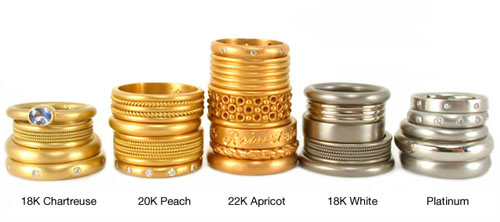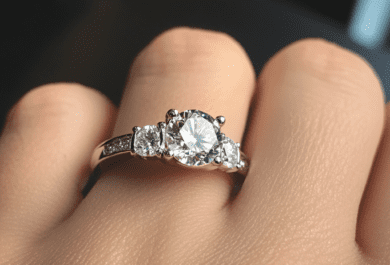Precious Metals

Precious Metals
Different Gold and Platinum Alloys
www.reinsteinross.com
When choosing a specific metal for your engagement ring, there are several things to consider. If you are shopping for your significant other, it is wise to match the metal to that individual’s other jewelry pieces. Does your partner primarily wear white gold jewelry, platinum jewelry, or yellow gold jewelry? What is his or her lifestyle? What is his or her profession? What metal is popular in his or her social circle and family? Will the overall design of the ring be simple or will it have intricate detailing? Consider these questions when you are choosing your metal.
Deciding between white gold and platinum? Please visit: White Gold vs. Platinum
Gold Rings
Gold engagement rings are typically made in 14k or 18k. You can choose either white or yellow gold. Higher karat gold, 22k and 24k, is not commonly used in engagement rings, but it is growing in popularity in the West. In some Eastern cultures, high karat gold is the norm for most jewelry.
14k gold = 58.5% gold
18k gold = 75% gold
White Gold Rings
White gold engagement rings are typically rhodium plated. White gold in its natural state is not actually white in color. It has a tinge of yellow, which is why it is plated. Rhodium plating is not permanent, so re-plating is necessary. Some may be able to go years without re-plating, while others may need to re-plate once a year. How often you need to re-plate will depend on your own body chemistry. White gold is often alloyed with nickel in the US, so if you have a nickel allergy, speak to your vendor about using a different alloy. Some prefer white gold without rhodium plating. The result is a warmer white hue.
Common Alloys: Nickel and Palladium
Yellow Gold Rings
Yellow gold engagement rings are making a comeback, and for some, it has always been the chosen metal. Yellow gold alloys are typically a combination of copper, silver and zinc. Copper alloy adds a reddish color, while silver adds a greenish color. The combination of the two alloys makes for an even gold color. 14k yellow gold will be lighter than 18k gold. Yellow gold can also make warmer colored diamonds appear more colorless, as the yellow color offsets a well-cut diamond.
Common Alloys: Copper, Silver, and Zinc
Rose Gold Rings
Rose gold engagement rings are made with copper as the primary alloy. 14k rose gold will generally be pinker in color, while 18k rose gold will have a subtler peach hue. There are many rose gold alloys available, as shown in the photo at the top of this page.
Common Alloy: Copper with smaller amounts of Silver
Platinum Rings
Platinum engagement rings are popular, because platinum is a very durable white metal that is more dense than gold. It is wise to make prongs out of platinum for strength and security. Platinum generally holds its color without the need for plating. Over time, a platinum ring will take on a grayish patina that can easily be polished away by a jeweler. The patina is the result of minute scratches over the surface of the metal. Some prefer the platinum patina, while others prefer to have their rings polished to remove it.
Common alloys: ruthenium, iridium, and cobalt
Palladium Rings
Palladium engagement rings are another option for those wanting a white metal that does not need plating. It is generally less expensive than platinum and it is much less dense. It is wise to choose a jeweler who is experienced in working with palladium.
Related Threads and Articles:
Next topic:
Solitaire Engagement Rings »












